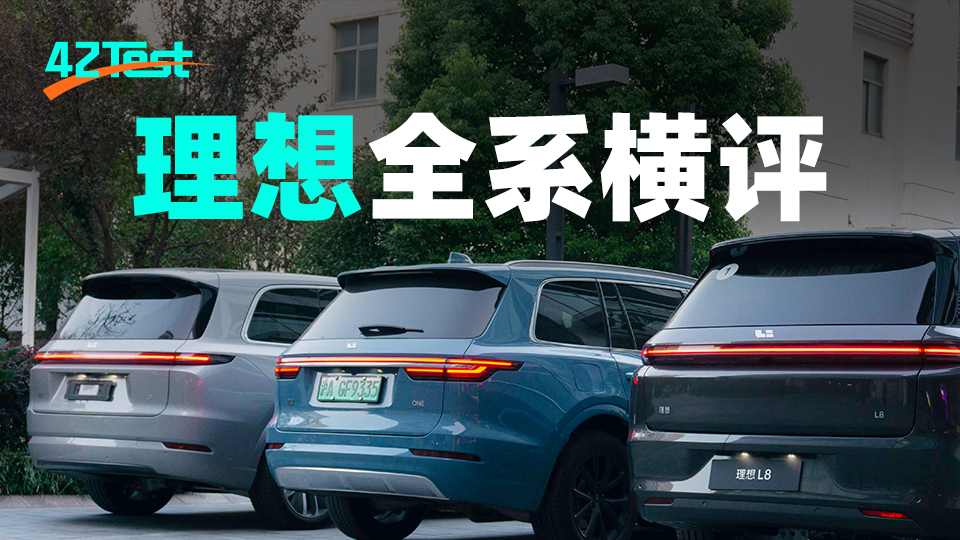On September 30th, the successor of the Ideal ONE — the Ideal L8 officially launched. On the same day, we have conducted a comprehensive static interpretation of the Ideal L8.
If you are interested in the comparison between the Ideal L8 and other models in the Ideal family, you can check out our 8,000-word analysis here: In-depth Comparison of Ideal L8: Is it just a smaller L9?. And if you are interested in the comparison between Ideal L8 and pure electric or million-level fuel SUVs in the same price range, here is another article for you: How does Ideal L8 compete with new pure electric and million-level fuel SUVs?.
During the National Day holiday, we had a chance to test drive the Ideal L8. However, in order to give you a stronger sense of how it performs, we also brought along its predecessor – the Ideal ONE, as well as Ideal’s flagship product – the Ideal L9 for a head-to-head comparison.
We will compare the four aspects of range, fuel economy, driving experience, and driver assistance technology between these models, to see how the new Ideal L8 has improved compared to the ONE, and what differences it has compared to the hardware-similar L9.
Range Test: Almost Accused Ideal ONE Unfairly
After getting our hands on the Ideal L8, we were most curious about whether the increased displacement and an extra cylinder would significantly increase fuel consumption compared to its predecessor – the Ideal ONE. Moreover, with the same powertrain, the Ideal L8 and L9 have the same nominal longest CLTC range of 1315 kilometers. While the paper specifications are identical, what are the differences in actual testing?
This time, in addition to testing the Ideal L8 using the 42Test, we also brought along the Ideal ONE and L9 for comparison, and the results are surprising.
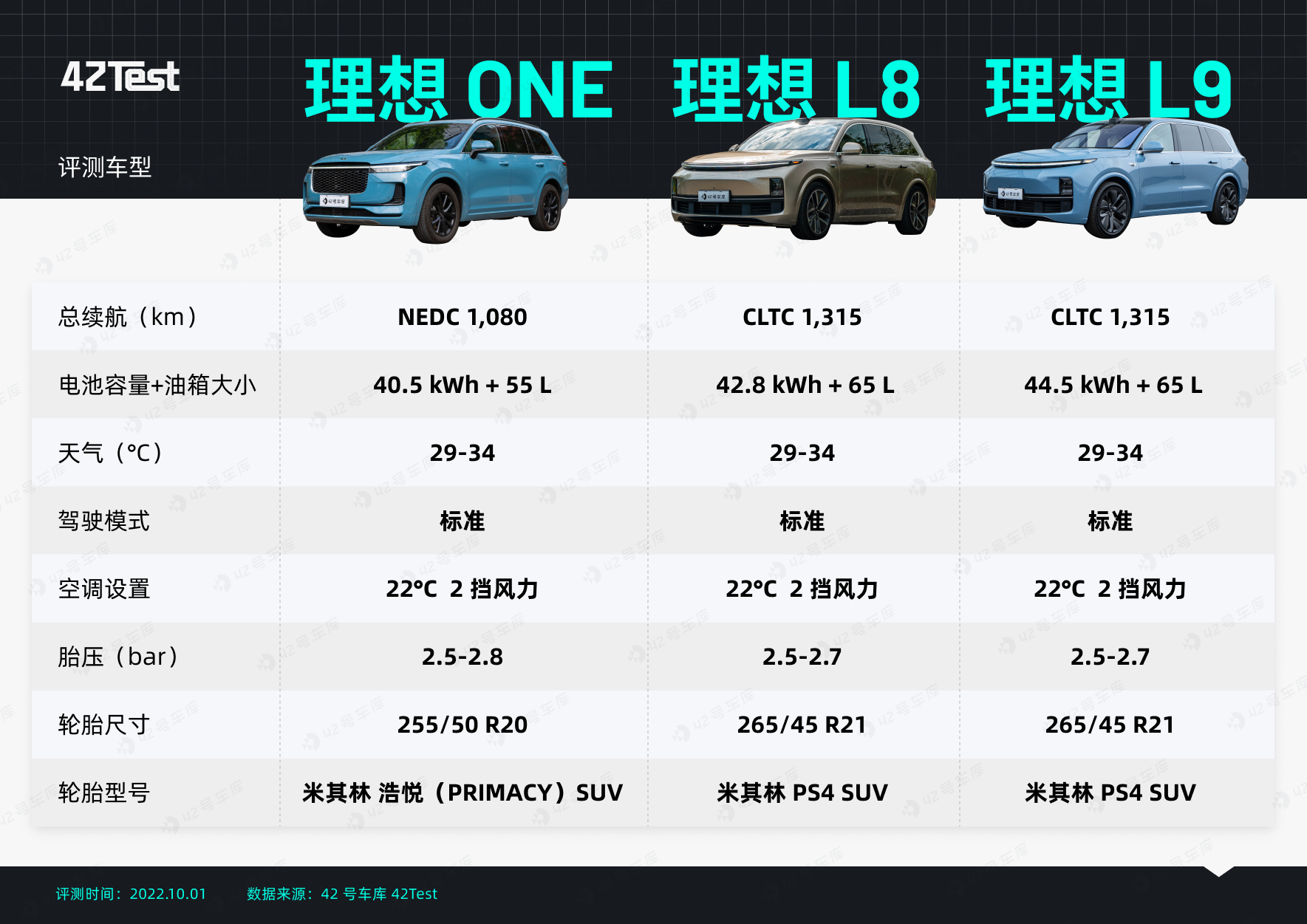
Only one EV completed the range test
Our testing environment was in Shanghai on October 1st. We drove for 50 kilometers in urban roads with moderate traffic, without any peak-hour traffic jam, but it can hardly be considered free-flowing either. After all, we went through traffic hubs such as Lujiazui, Huaihai Road, Xuhui Riverside, Wukang Mansion, and Yan’an Road, which naturally comes with heavy traffic and pedestrians.同时, there may inevitably be several congested sections on the 100 km outer ring road, which can represent the difference in endurance of these three cars to a certain extent.
On October 1st, with the temperature fluctuating between 29-34°C, we set the air conditioner of the three cars to 22°C with level 2 wind. After fully charging the batteries of the vehicles, we started the 150 km urban pure electric test.
After fully charged, the displayed WLTC pure electric endurance of the Ideal ONE, Ideal L8, and Ideal L9 were 155 km, 170 km, and 180 km, respectively, which corresponded exactly to the battery pack sizes of the three cars. The test took about 240 minutes to complete.
In the pure electric test, we set the vehicle mode to pure electric priority. Only the Ideal L9 completed the entire test relying on its own large 44.5 kWh battery pack, while the remaining two cars automatically switched to range-extender during the test. The most dramatic moment was that Ideal L8 and Ideal ONE started the range-extender almost at the same time and same mileage.
During the formation driving, the tester on the Ideal ONE noticed that the range-extender had been started. Not long after, the Ideal L8 also sent a signal to start the range-extender. Both cars started at 138 km, and it was even hard to tell which one started earlier.
After starting, the Ideal ONE had a remaining WLTC pure electric endurance of 25 km, and the Ideal L8 had 34 km, both at around 20%.
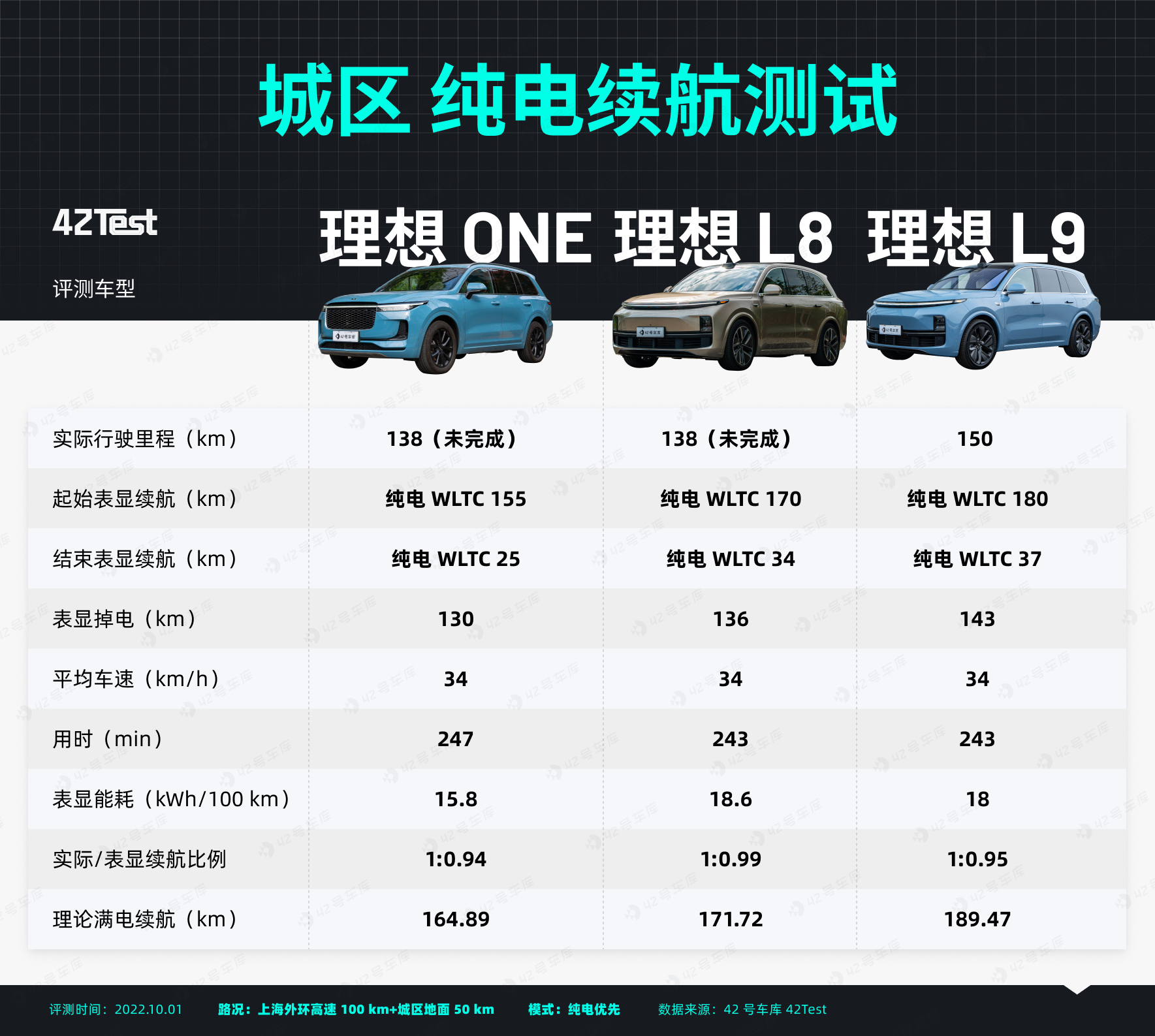
In the urban pure electric test, the Ideal ONE had the best energy consumption performance with weaker power but slightly heavier weight, achieving 15.8 kWh/100 km, followed by Ideal L9, and lastly Ideal L8. However, the energy consumption difference between L9 and L8 was not significant. Moreover, the actual/displayed ratio of battery level drop of these three cars was very close to 1:1, which indicated the high credibility of their displayed endurance mileage in daily use.
Urban Fuel Consumption: Astonishingly Low L8
Once all three vehicles had depleted their batteries and initiated their range extender, we drove directly to the gas station to refill the gas tanks to the first click, and conducted fuel consumption tests under the deficit electricity mode.
Under the same road conditions and route, it took nearly the same duration of 243 minutes to complete one full circle as we did in the morning.
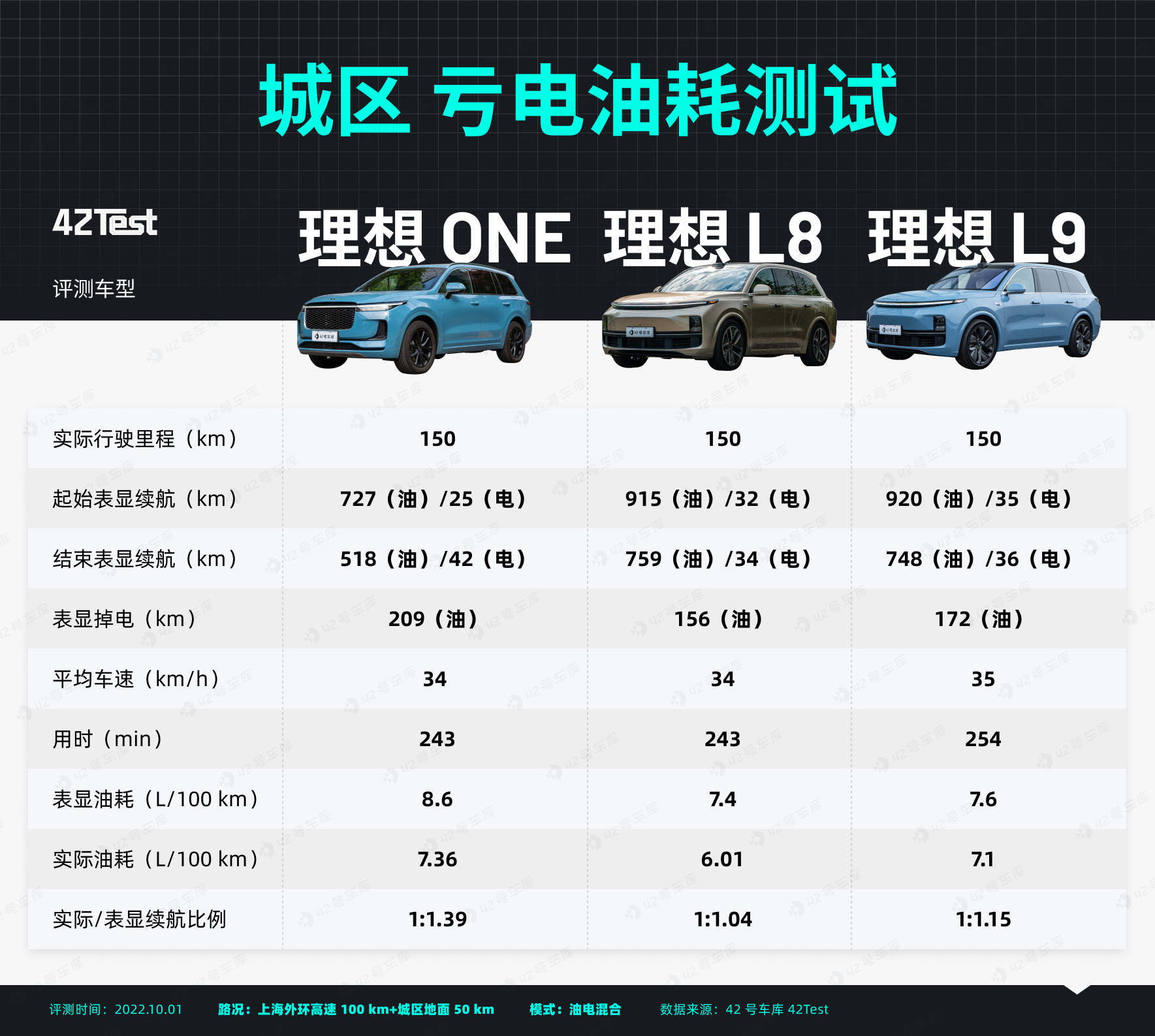
Surprisingly, the larger displacement, more cylinders, and more powerful Idean L8 and L9 displayed lower energy consumption than the Idean ONE this time, with fuel consumption rates of 7.4 L/100 km for L8 and 7.6 L/100 km for L9, respectively, versus 8.6 L/100 km for the 1.2 L three-cylinder Idean ONE. To verify that there was no speedometer fraud, we refilled all three vehicles’ gas tanks to full at the starting point gas station.
We calculated the average fuel consumption based on the total distance traveled and the fuel added: 6.01 L/100 km for Idean L8, 7.1 L/100 km for Idean L9, and 7.36 L/100 km for Idean ONE.
The most surprising finding was that the Idean L8 achieved an incredibly low fuel consumption rate of only 6 L per 100 km. It would be difficult for a 1.4 L compact gasoline SUV to match such fuel efficiency. Are the Idean ONE’s owners envious?
In addition, all three vehicles’ speedometers displayed higher readings than the actual mileage, with their actual/effective ranges exceeding 1. This indicates that the three range extender vehicles are very friendly to use in the city, especially when driving on elevated roads.
What is worth mentioning is that the curves showing the decline of the pure electric range for Idean L8 and L9 were smooth with hardly any fluctuations throughout the entire 150 km test. The difference between the initial and final reading of the electric range display was only between 1-2 km, which can be considered negligible. This means that the additional electricity generated by these two vehicles was also involved in driving the vehicles in hybrid mode.
And under the situation of power loss, the pure electric endurance mileage of the Ideal ONE has increased by 17 km compared with the initial mileage, so although the fuel consumption is relatively high, the Ideal ONE has an additional 17 km pure electric endurance which did not participate in the driving. If the vehicle automatically incorporates these 17 km into the driving, theoretically, the fuel consumption will be further reduced. Therefore, we have a bold idea to examine whether the Ideal ONE, in long-distance high-speed driving (hybrid mode), will participate in driving with electric energy like L8 and L9, or become more electric as the car travels.
L9 wins narrowly in power loss high-speed test
After two urban area tests, we returned to the gas station to fill up the gas tank again. As for the Ideal ONE, we lowered its power to about 20%, and turned on the range extender for the next round of testing.
For the high-speed test, we departed from a location 200 meters adjacent to the outer ring highway entrance, and drove to Hangzhou, and returned to the gas station via the Hangzhou Xiaoshan district. The total distance is 325 km. The total time we spent was 206 minutes, with an average speed of around 95 km/h.
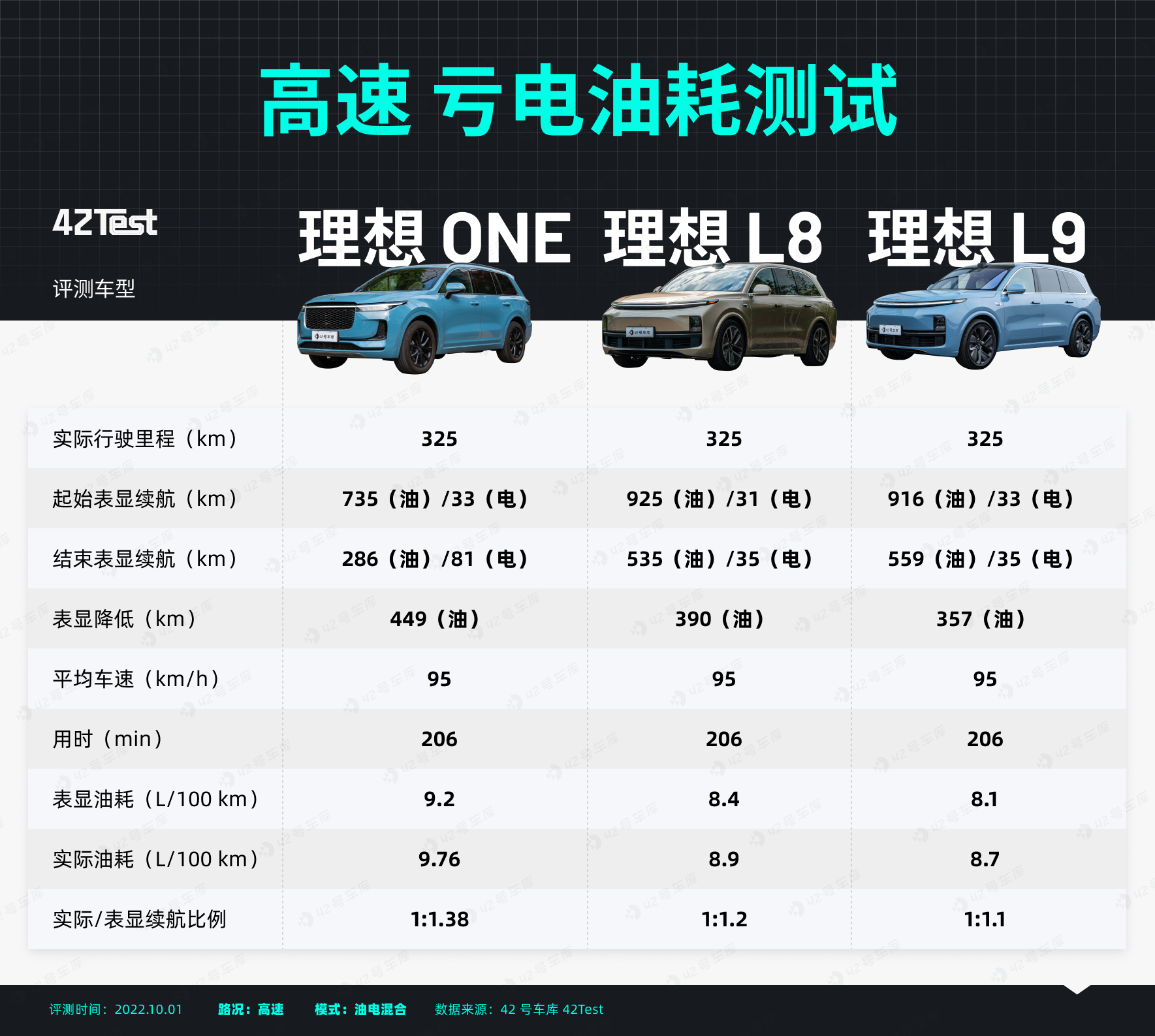
After completing the roundtrip, the display power consumption of the Ideal L8 was 8.4 L/100 km, the Ideal L9 was 8.1 L/100 km, and the fuel consumption of the Ideal ONE still remained high at 9.2 L/100 km.
At the same time, we also refilled the gas to the automatic stop and calculated the actual fuel consumption by dividing the fuel filled by the actual driving mileage. The actual fuel consumption of the Ideal L8 was 8.9 L/100 km, the Ideal L9 was 8.7 L/100 km, and the Ideal ONE was 9.76 L/100 km.
To this point, we can see that the high-speed fuel consumption no longer shows the “joyful expression” of urban fuel consumption. The actual fuel consumption of the three cars is 0.5-0.6 L/100 km higher than the displayed fuel consumption.
Therefore, jumping out of the sweet interval of urban working conditions, the displayed fuel consumption seems less practical. Therefore, the actual/displayed cruising range ratio is also between 1.1-1.38, which still has some reference value.
Next, let’s continue to look at the changes in the displayed pure electric cruising range of the three cars in this 325 km journey. The test results of Ideal L8 and Ideal L9 are consistent with the power consumption in urban areas before. The difference between the initial and final displayed pure electric cruising ranges is between 2-4 km, which can be ignored.
This also indicates that these two cars always keep the power level at around 20% in the hybrid mode, and the extra power is directly used for driving the vehicle.
And Ideal ONE has verified our speculation, with an initial pure electric cruising range of 33 km, the pure electric cruising range after 325 km reaches 81 km, exceeding 48 km, which is why the fuel consumption of Ideal ONE remains high.
Here we make a less rigorous speculation, if we calculate this 48 km as 70% and add it to the high-speed fuel consumption, the final fuel consumption of Ideal ONE will be around 8.75 L/100 km, and Ideal ONE almost got misrepresented by us. But even if it is on par with Ideal L8 and L9, if owners want to reduce fuel consumption in the hybrid mode, they need to switch the vehicle’s mode manually.
Overall, in this endurance competition, the competition between Ideal L8 and Ideal L9 with the same powertrain is very intense, and it is difficult to find significant differences between the two. If we ignore the differences in driving habits between drivers, the differences between the two will narrow further.
On the side of Ideal ONE, in the case of not switching modes manually, its fuel consumption can be said to be one level higher than that of L8 and L9. However, if owners switch modes manually and involve the extra power in driving, the fuel consumption of Ideal ONE will not be much worse.Thus, this indirectly reflects the strategic difference between the Ideal ONE and the Ideal L8/L9 models. Under the same hybrid mode, the L8 and L9 models are smarter and will actively involve the electric power to reduce fuel consumption, while the Ideal ONE model will still charge even in hybrid mode. Therefore, the L8 and L9 models can better distinguish between the two modes of forced fuel and electric-hybrid.
Charging
A group of data is critical for the Ideal ONE customer profile, which is that 78.9% of users choose to use the pure electric mode. Therefore, not only is it necessary to conduct a pure electric endurance test, but we also arranged a charging test.

Let’s look at the Ideal ONE model with a 38.5 kWh battery, which takes 46 minutes to go from 20% to 95% battery SoC. The voltage climbed from 357 V to 401 V, and the current dropped from 155 A to 35 A when reaching 95%.

The L8 and L9 models are obviously faster than the Ideal ONE. The L8 model takes 42 minutes to go from 20% to 95% battery SoC with a 42.8 kWh battery, and the voltage climbs from 373 V to 421 V. The current drops from 198 A to 41 A when reaching 95%.

The L9 model with a 44.5 kWh battery becomes the winner of this test. It takes 39 minutes to go from 20% to 95% battery SoC with the voltage climbing from 388 V to 436 V; the current drops from 198 A to 41 A when reaching 95%. Moreover, by carefully observing, the L9 model can get higher charging power at the same current because it has a larger battery, obtaining indeed a faster overall charging speed compared to the L8 model.
Driving experience: Larger, but lighter, and more comfortable!
Before the L8 model’s launch, we had a chance to drive it on an enclosed field, and the feeling was “light and agile.” After we got the actual vehicle and conducted a 1,000 km test drive, this feeling was validated time and time again.
The agility of this car is reflected in multiple dimensions, and the most significant of which is the steering feel. The steering of L8 in all modes has lighter damping than the 2021 model ONE, and the response of the front of the car is a bit quicker.
The steering of L8 and L9 has three adjustable modes: comfort, standard, and sport. However, regardless of the mode, the damping setting for this steering makes some colleagues in the editorial department feel a bit too light, losing the sense of stability that a medium-sized SUV should have. But the benefit is that for female drivers, such damping settings make it very easy to get started and not feel the car is bulky.
On the other hand, the steering damping of the 2021 model ONE still has a sense of weight in standard mode, and it will be slightly lighter in comfort mode.
(Driving options for Ideal L8)
The driving mode settings of L8 and L9 and the concept of XPeng G9 are both straight male styles, but the results are completely different: the Ideal seeks to reduce the complexity of the driving mode settings and focus on the comfort configuration of the car.
(Power options for the XPeng G9 dual-chamber air suspension version)
On the other hand, XPeng G9 has completely released all power function decoupling to users, which is also a very important selling point of the G9 product itself.
Suspension is very comfortable
L8/L9 achieves the “Magic Carpet Air” function through hardware configurations such as air suspension and CDC and its self-developed XCU central domain controller. Emphasis is on “floating feeling,” or comfort.
If we roughly divide the surface roughness of the road into low, medium, and high levels, then L8/L9 is very effective in filtering for medium-level rough roads, and L8/L9 is also the most comfortable of the vehicles we have recently tested, including the NIO ES7, XPeng G9, and Avita 11.
How exaggerated is this sensation?
As we drove from the asphalt road into the parking lot paved with stones in the enclosed area, we hardly felt the difference in the two completely different ground materials from inside the car! Only by the “rustling” sound coming from outside could we tell that we were already on the stones.
For some road joints, small potholes, and small ridges, L8/L9 also absorbs and dissolves most of the vibrations. On the contrary, this suspension system will retain high-frequency vibrations, such as vibrations transmitted through the tires and felt on the steering wheel and seat cushions, allowing the driver to sense the road feel from asphalt particles.
Low-frequency vibrations correspond to speed bumps, large potholes, and ridges. When driving at low speeds over speed bumps, L8/L9 can clearly feel the special texture and sound brought by the air suspension, and the front and rear suspension can dissolve the vibrations in one cycle. Of course, if you look carefully, you can also feel a little more aftershocks on the rear axle than on the front after passing over speed bumps.
When driving at high speeds over these obstacles discontinuously, the vibration cycle of L8/L9 can still be kept within one cycle.
Now let’s switch back to the 2021 model IDEAL ONE, which has a much harder MacPherson front structure and overall suspension settings than L8/L9.
For example, when passing over speed bumps at low speeds, you can hear and feel the obvious impact of the speed bump on the 2021 model IDEAL ONE. However, when facing high-speed low-frequency obstacles, the suspension of the 2021 model IDEAL ONE appears to be a little nervous, and the vibration will lag behind the vehicle’s up-and-down oscillation in two cycles.
Another improvement of L8/L9 compared with the 2021 model IDEAL ONE is the control of the body’s frontal and rear pitching movements. When accelerating or braking, the front of the vehicle pitches more obviously on the IDEAL ONE, while there is a great improvement on the L8/L9. On the one hand, it adopts a better front suspension structure, and on the other hand, the addition of the CDC suspension system allows IDEAL to dynamically adjust the damping of the front and rear suspension to control pitching movements.
Acceleration & Braking Performance
We conducted continuous 10 times 0-100 km/h acceleration and 100-0 km/h braking distance tests on the L8, L9, and 2021 Ideal ONE. The test environment temperature was around 30℃, and the battery SoC of the three cars was above 80% during the test.
According to the conventional setting, we need to open the Sport Mode or Track Mode to release the vehicle’s maximum power. However, for Ideal, “Launch Mode” can release the power completely.
There is a small tip when measuring acceleration. For these extended range models of Ideal, you need to step on the brake and accelerator pedals at the same time. At this time, the extender will enter a high-power state of operation, and after releasing the brake, the battery and extender will provide power to the drive motor together. General electric vehicles do not need to “hold the speed” like fuel vehicles.
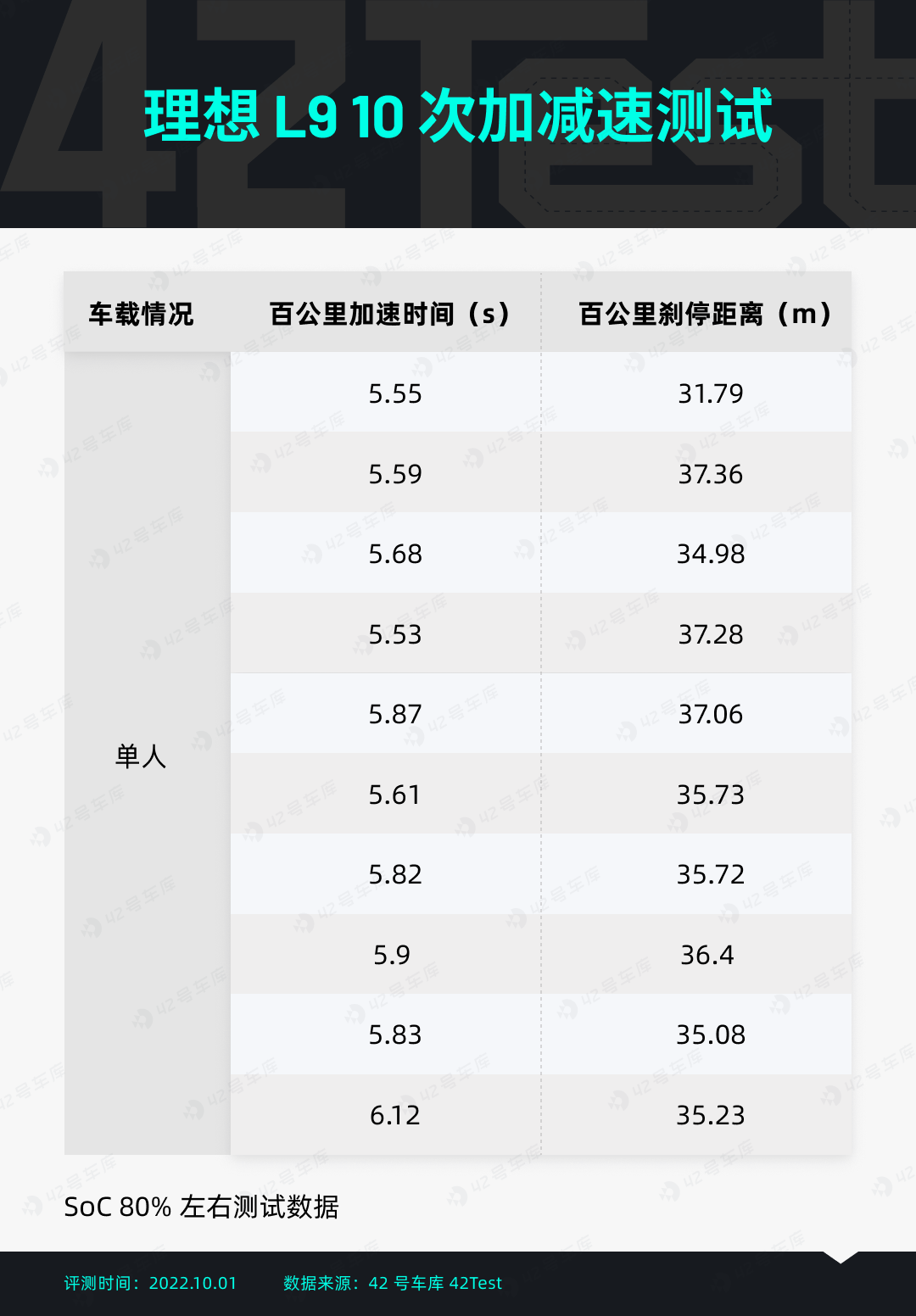
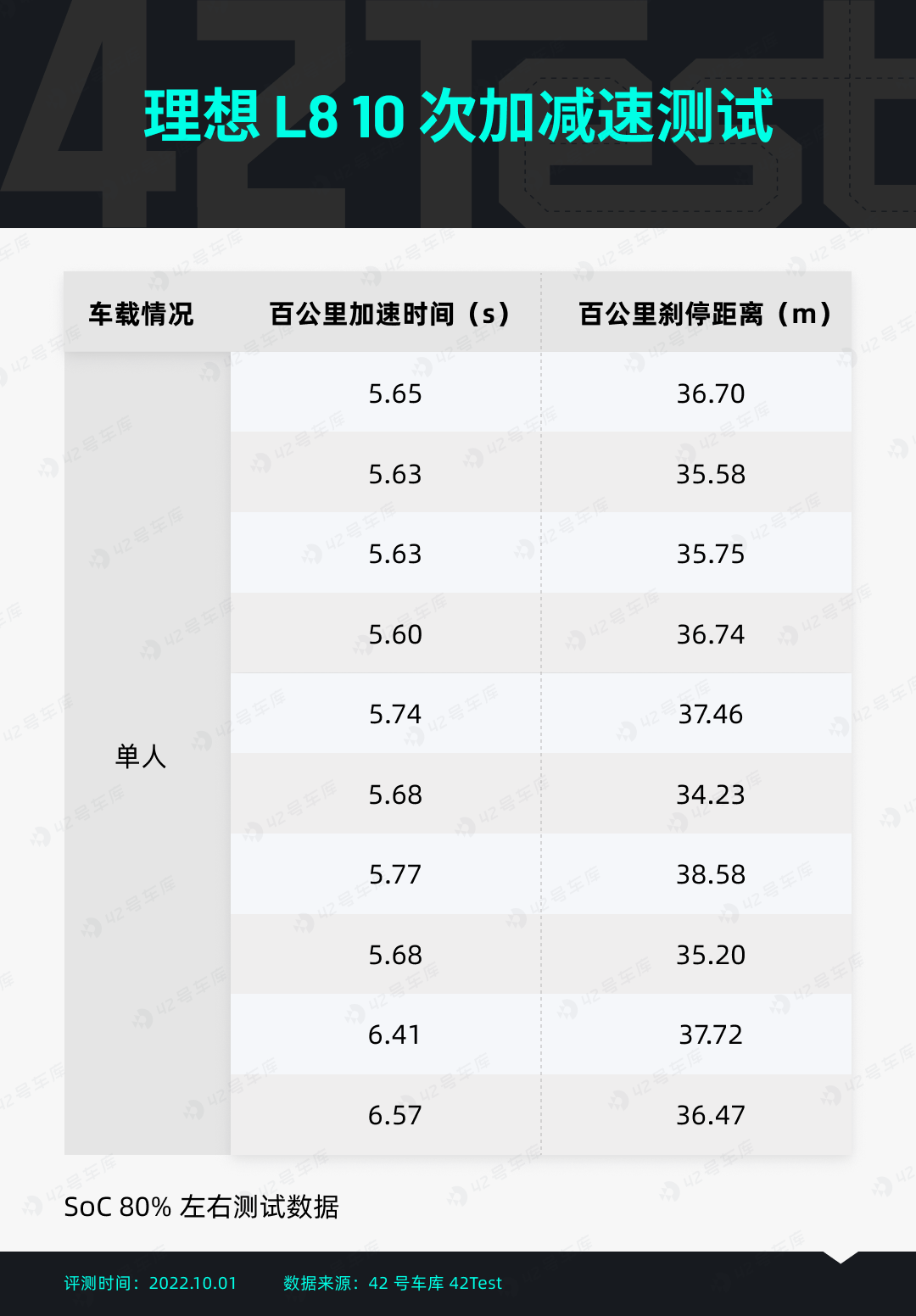
Although L8 and L9 adopt the same drive motor, and the peak power can reach 330 kW, and the torque can reach 620 N·m, there is a 0.2 s difference in acceleration between the two in the official data.
And this point is also confirmed in our continuous acceleration test: L8 is not faster than L9. At the same time, the acceleration decay of L8 and L9 is relatively severe. The difference between the maximum and minimum values of L8’s ten acceleration tests is 0.92 s.
L9 achieved an impressive score of 32 meters in the first brake foot in the test. The average braking distance for ten times is 35.66 m, while the average braking distance for L8 for ten times is 36.44 m. The continuous braking test of the two did not show obvious thermal decay.
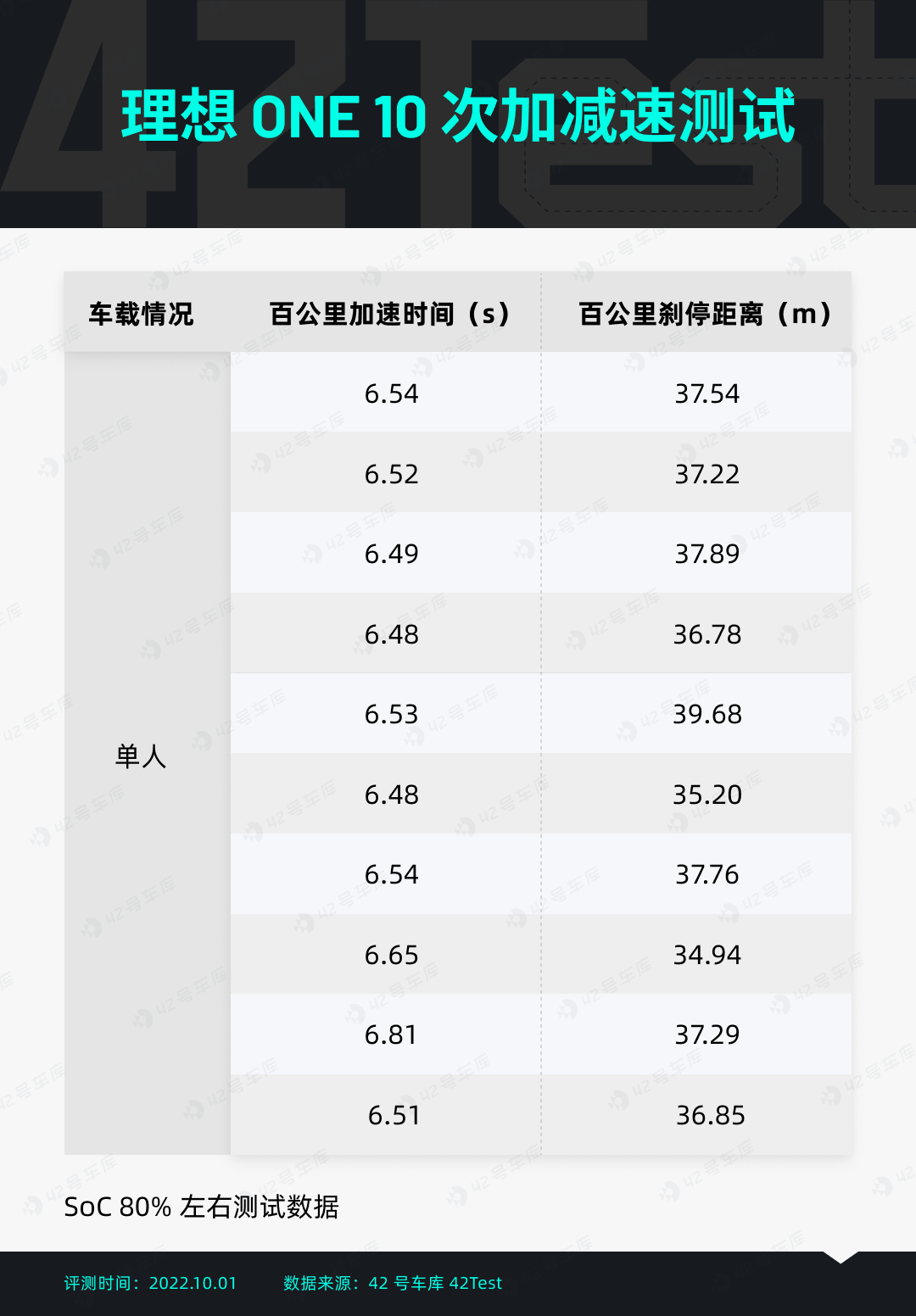 Comparatively interestingly, the deceleration after continuous acceleration of the Ideal ONE is not significant in a basically consistent test environment, and the thermal attenuation performance of braking at the same time is also good, with an average braking distance of 37.11 m in 10 consecutive times.
Comparatively interestingly, the deceleration after continuous acceleration of the Ideal ONE is not significant in a basically consistent test environment, and the thermal attenuation performance of braking at the same time is also good, with an average braking distance of 37.11 m in 10 consecutive times.
In actual driving, the acceleration and braking pedal styles of Ideal L8 and L9 are consistent with the style of Ideal ONE.
There is some empty space in the front of the accelerator pedal, which is not a delay, and more power will be released in the middle and late stages, and the damping setting is relatively light. The damping setting of the brake pedal is slightly heavy, which gives a sense of a large vehicle.
What deserves to be criticized is that neither Ideal L8 nor L9 have a display function that can be used to view the kinetic energy recovery power in real-time on the car’s entertainment system.
NVH
Everyone will focus their energy on this 1.5T four-cylinder engine, and in addition to a significant improvement in energy consumption, L8/L9 also have a great improvement in suppressing vibration.
After completing the electric test in the urban area, L8/L9 have entered the loss of power state. In the hybrid mode, the range extender is started when the speed is around 40 km/h. And this speed is observed from the power flow display of the center console. It is difficult to feel that the range extender is working directly through vibration and sound when parking or driving normally.
This improvement compared to the Ideal ONE is not small, because in the loss of power state, the range extender will start almost every time when starting and accelerating at the red light. L8/L9 are difficult to detect, while Ideal ONE can hear the range extender working at this time through the sound.
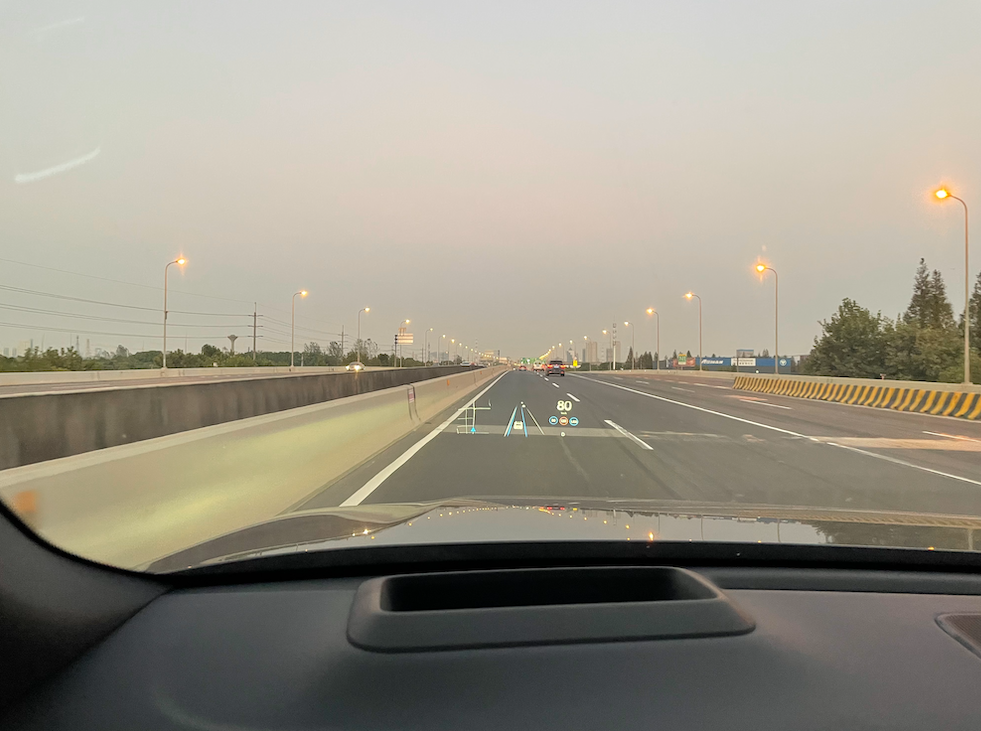
Of course, the sound of the range extender is not so imperceptible, and when the power is lost, it can still be heard when the accelerator pedal is sharply depressed. However, this sound is more low-pitched and pleasant than the Ideal ONE, and it is not easy to raise the speed to produce a whining sound.We also tested the noise level of the three car cabins. To ensure the accuracy of the test results, we drove on enclosed roads at speeds of 60, 80, 100, and 120 km/h, and collected samples of driver noise three times, taking an average each time.
As shown in the chart above, the noise level in the driver’s seat of the L8/L9 is better controlled than that of Idean ONE, which is consistent with our actual experience.
Looking closely at the chart, you may wonder why the noise level inside the car does not increase significantly after the range extender is started.
Here, we need to emphasize that timbre and volume are two different concepts, and our decibel meter only measures the volume. During the test, our tester found that although he could hear the sound of the range extender, the actual value measured by the decibel meter did not increase much.
Overall, the driving style of Idean L8 is more comfortable than that of Idean ONE. While most recently launched models emphasize sportiness, the L8 is definitely one of the most comfortable ones. It is also this focus on comfort that unifies the car’s acceleration, braking, and steering into a more linear whole.
ADAS: Differences lie in the future
After experiencing the acceleration and deceleration on the track, we tested the ADAS function of Idean L8 on the circular track. Idean L8 has two versions: Pro and Max. The vehicle we tested is the Max version, and the ADAS hardware is equipped with AD Max, which has exactly the same specifications as the L9. The following table shows the ADAS configurations of each model:
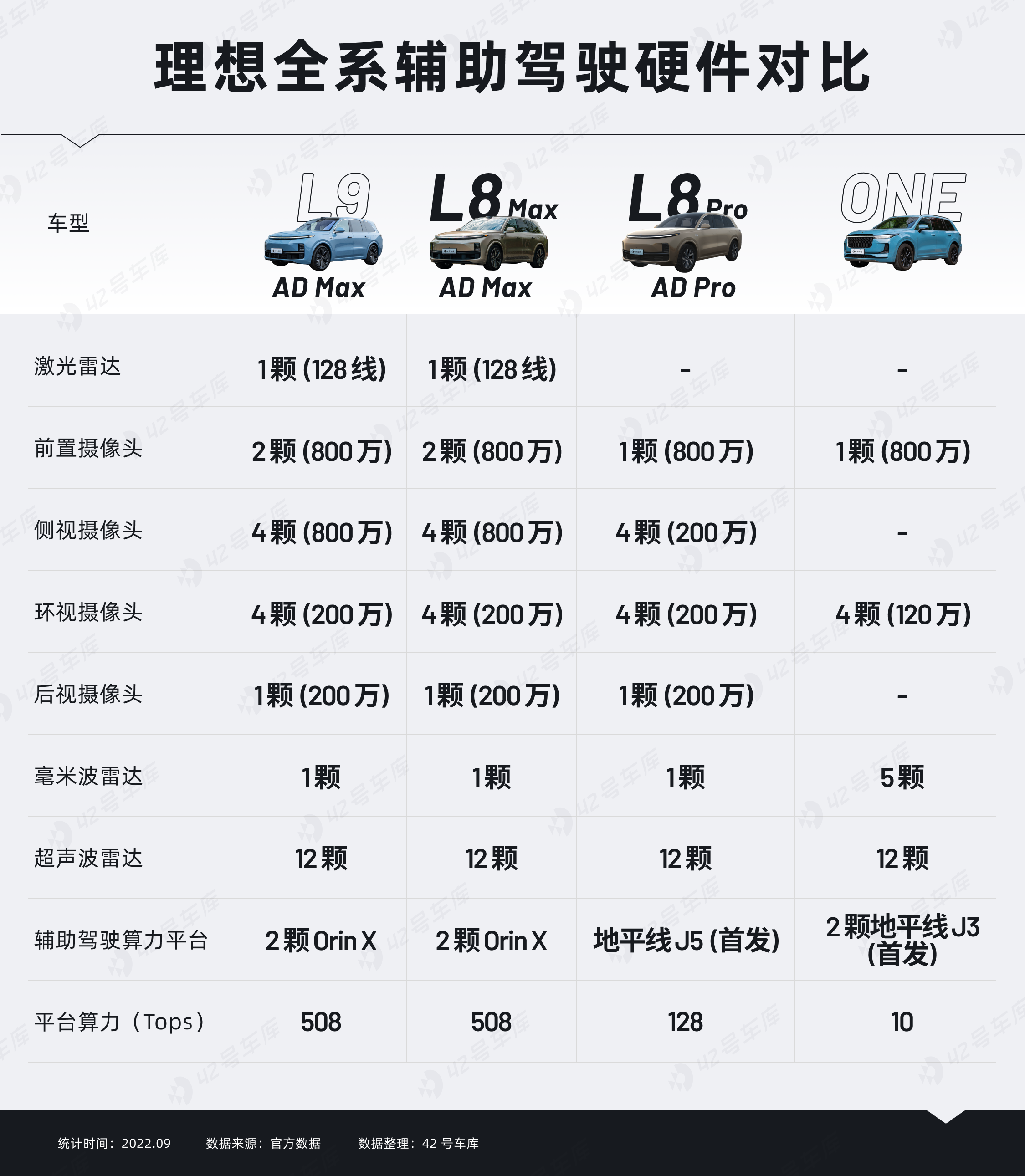 The Ideal L8, whether the Pro or Max version, tends to pursue a pure visual route. The Max version only retains a forward millimeter wave. In August of this year, when the Ideal L9 was delivered, the NOA high-speed navigation assisted driving function was synchronized, which was the first navigation-assisted driving based on Orin-X. Similarly, the L8 Max we experienced this time also has the navigation-assisted driving function. Therefore, we also brought the previous generation product, Ideal ONE, and the same hardware Ideal L9 for comparison.
The Ideal L8, whether the Pro or Max version, tends to pursue a pure visual route. The Max version only retains a forward millimeter wave. In August of this year, when the Ideal L9 was delivered, the NOA high-speed navigation assisted driving function was synchronized, which was the first navigation-assisted driving based on Orin-X. Similarly, the L8 Max we experienced this time also has the navigation-assisted driving function. Therefore, we also brought the previous generation product, Ideal ONE, and the same hardware Ideal L9 for comparison.
Talking about the basic assisted driving experience, the most impressive point of Ideal L8 to me is that the longitudinal acceleration and deceleration control is well done. In terms of longitudinal distance adjustment, Ideal L8 has three gears that can be adjusted: close, medium, and far. Even at the shortest following distance, Ideal L8 still leaves a very generous safety distance between the front car.
For someone like me who is very familiar with assisted driving, the close gear is the most comfortable gear I think, it will not be frequently cut in by other cars, nor will there be a feeling of panic due to following too closely. At the same time, this is also where Ideal L8’s performance of 128-line lidar on the forehead can be reflected.
During the following process, no matter whether the front car brakes with greater force or slight force, Ideal L8 will control the speed with a more comfortable deceleration rate G value, and the way of adjusting speed is also very delicate.
For example, during the test, we encountered a social car with malfunctioning taillights that could not be illuminated. When driving manually, humans will deliberately increase the distance and leave enough reaction time in such situations. However, when we use the L8 AD Max, the system can sensitively capture the front car’s deceleration action, thereby applying the brakes. Compared with human driving that relies on tail lights to recognize deceleration, the system’s response speed is faster.
Therefore, Ideal L8’s safety distance is not left by heavy braking like other vehicles, but balanced by very sensitive reactions, safety braking distance and comfortable deceleration rate. In daily use, Ideal L8’s ACC is very suitable for assisted driving when traveling with family.
In terms of lateral control, the Ideal L8 currently does not have a big gap with the Ideal ONE. When driving on a wide, clear lane, the vehicle can easily stay in the middle of the road. However, when driving on a high-speed right-turn with a large curvature, the driver will feel that the vehicle has a tendency to veer to the left. As the curvature increases, the vehicle’s deceleration and steering response will be slightly slower, which can cause great psychological pressure on the driver and prompt them to take over the control.
At this time, if high-precision map data is available and the NOA (Navigation-guided Autonomous Driving) is activated, the vehicle’s stability and centering in high-speed turns will be significantly improved. In addition, compared to the Ideal ONE, with the use of full-surround perception, the L8 can automatically change lanes without the driver having to confirm by pressing a button, which is more convenient when dealing with frequent lane changes and overtaking situations.
The logic of the Ideal L8 in NOA mode is more aggressive than that of the Ideal ONE. When there is a slow vehicle ahead and the speed difference is more than 10 km/h, it will directly trigger the predictive overtaking without the need to decelerate, smoothly passing the slow vehicle.
However, after overtaking, the Ideal L8 does not immediately return to its original lane. If there is no slow vehicle ahead, it will run on the same lane for a period of time. This logic is also present when merging onto the main road from the ramp. The vehicle does not immediately change lanes multiple times to enter the fast lane on the left, but gradually changes lanes to the fast lane after encountering a large or slow vehicle ahead. This is slightly different from the logic of the Ideal ONE. Which logic is better depends on the individual preference. However, the L8’s approach can slightly reduce the number of invalid lane changes.
As the use of the NOA system in the L8 deepens, some minor problems have also emerged, which are also common to the L9 with the same hardware and computing platform.First of all, due to the wide body of the car, it is not obvious when avoiding larger vehicles. When a large vehicle is running at 80 km/h, it is difficult not to worry about whether there will be any scrapes on the right side when you fly past it at a speed of 120 km/h. In addition, the HUD highlights the large vehicle in red, adding even more pressure on the driver.
Moreover, we found that there was a significant left-right swerve when merging onto the Shanghai-bound Hangzhou-Ningbo Expressway from the Shanghai-Kunming Expressway. Due to the extremely wide lane stripes, the vehicle swayed left and right, as if searching for a lane line. Finally, as the lane narrowed and the lane lines gradually became clearer, straight driving was gradually restored. Theoretically, after NOA is activated, the vehicle will match high-precision map data for driving and such situations should not occur.
At present, the L8 assisted driving system is still in a relatively early stage, and its overall performance has not surprised us too much. With the accumulation of data and the iteration of software versions in the future, there is still great potential to be explored in the hardware of the ideal L8 assisted driving system.
The hardware stack we see on the AD Max is meant to provide hardware support for more advanced assistance in the future. At the press conference on September 30th, Li Xiang emphasized that L4 would be achieved by 2025. When the autonomous learning reaches 10 billion kilometers, the AD Max urban FSD will also meet us.
Conclusion
After a deep test drive of 1,000 kilometers, we have felt the significant improvements of the X platform in terms of energy consumption, driving experience, and assisted driving.
However, the issues we encountered during the static test drive remained. After the dynamic test drive, the overall experience of L8 and L9 was almost the same, except for their differences in appearance and core configurations. The core difference still lies in space.
The L8 Max version we tested already costs more than 400,000 RMB. In this price range, we can buy many other products. If we want a brand, we can buy Audi Q5 e-tron. If we want space, we can buy Volkswagen Touareg or even Toyota Sienna.However, there is no difference in driving configuration between the L8 Pro version and the L8 Max, and L9. This means that the driving experience can be expected to be basically the same. Therefore, for the price of 359,800 yuan, you can already enjoy features such as air suspension, CDC, 330 kW of power that matches the GLE 53 AMG, an advanced driving assistance system, a cabin with a 3K resolution large screen, a 19-speaker 1920-watt 7.3.4 channel audio system, and three rows of electrically adjustable and heated seats.
In terms of their own product line, the improvement of the ideal L8 Pro compared to the ONE has already far exceeded the value difference of 10,000 yuan. The overall quality and experience of the car is almost on par with the big brother L9.
Thus, whether it is placed within their own product line or among competitors, the Ideal L8 is a very competitive product. Therefore, the new question is, how many people are waiting for the L8 Pro?
This article is a translation by ChatGPT of a Chinese report from 42HOW. If you have any questions about it, please email bd@42how.com.
